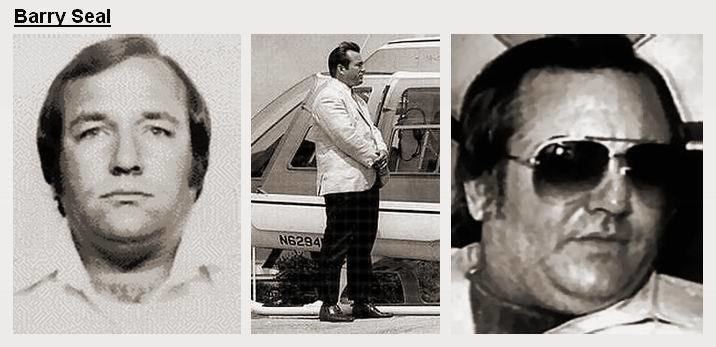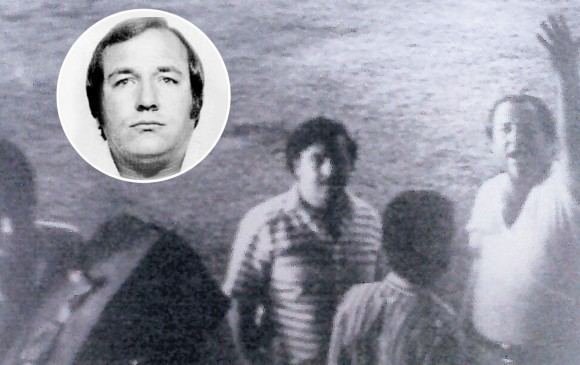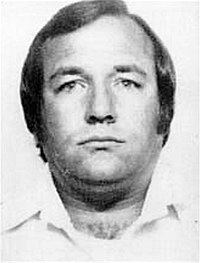Name Barry Seal | ||
 | ||
Full Name Adler Berriman Seal Children Adler Seal, Lisa Seal Frigon, Aaron Seal, Dean Berriman Seal, Christina Seal Parents Mary Lou Seal, Benjamin Curtis Seal Similar People Pablo Escobar, Carlos Lehder, Oliver North, Roger Young, Dennis Hopper | ||
Adler Berriman "Barry" Seal (July 16, 1939 – February 19, 1986) was an American airline pilot who became a major drug smuggler for the Medellín Cartel. When Seal was convicted of smuggling charges, he became an informant for the Drug Enforcement Administration and testified in several major drug trials. He was murdered in 1986 by contract killers hired by the Medellíns.
Contents
- Early life
- Early career
- Drug smuggling career
- Undercover informant and operative
- Assassination
- Books
- Films
- Television
- References

Early life

Seal, born in Baton Rouge, Louisiana, was the son of Mary Lou (née Delcambre) and Benjamin Curtis Seal, a candy wholesaler. Seal began flying as a teenager. According to his flight instructor, he was a naturally gifted pilot. He earned his student pilot license at 15 and a regular pilot's license at 16.

In 1961, Seal enlisted in the Louisiana Army National Guard for six years, serving with the 20th Special Forces Group. He graduated from United States Army Airborne School but never completed United States Army Special Forces selection and training. Seal later served in the 245th Engineer Battalion with his MOS being radio telephone operator.
Early career

Seal joined TWA as a flight engineer in 1967, and was soon promoted to command pilot, flying a Boeing 707 on a regular Western Europe route. He was one of the youngest 707 command pilots in the TWA fleet.

Seal's career with TWA ended in July 1972 when he was arrested for involvement in a conspiracy to smuggle a shipment of plastic explosives to Mexico using a DC-4. The case was eventually dismissed in 1974 for prosecutorial misconduct, but TWA in the meantime fired Seal, who had falsely taken medical leave to participate in the scheme.
Drug smuggling career
According to statements Seal later made after he became a DEA informant, he began smuggling small quantities of marijuana in 1976. By 1978, however, he had begun flying significant loads of cocaine because pound-for-pound it was more profitable to carry "coke than weed."
In December 1979, Seal was arrested in Honduras after a tip that he was returning from a drug smuggling trip to Ecuador. Although the Honduran police did not find any cocaine, they did find an M-1 rifle, and Seal was imprisoned until July 1980. Undeterred by his arrest, Seal expanded his operations on his return to the United States. He hired William Bottoms, his ex-brother-in-law as a pilot and from 1980 on, Bottoms was the main pilot in Seal's smuggling, while Seal oversaw planning and operations.
Seal later began working for the Medellín Cartel as a pilot and drug smuggler. He transported numerous shipments of cocaine from Colombia and Panama to the United States and earned as much as $500,000 per flight.
After successful runs at his home base in Louisiana he moved operations to Mena Intermountain Municipal Airport, an airport facility in Mena, Arkansas. There he bought, sold, and operated many planes.
Undercover informant and operative
Seal was eventually arrested in connection with his drug smuggling activities. In a Florida federal court, he was indicted, tried, convicted, and sentenced to 10 years in prison. After his sentencing, Seal approached the DEA and offered to cooperate with the government as an informant. Federal officials agreed to use him as an informant and mentioned his cooperation during hearings in which Seal sought a reduction of his sentence. With an agreement reached, Seal began working as a federal informant in March 1984.
According to the Frontline: Godfather of Cocaine investigation, Ernst "Jake" Jacobson was Seal's DEA handler during this period. Jacobson claims he still has the high-tech message encrypter which he gave Seal. In order to mitigate his 1984 arrest in Fort Lauderdale, Florida for money laundering and Quaalude smuggling, Seal agreed to testify against his former employers and associates in the drug trade, and thereby contributed to putting several of them in jail. Among those Seal testified against were Chief Minister of the Turks and Caicos Islands Norman Saunders and members of the Medellín Cartel. Seal also testified before the President's Commission on Organized Crime in October 1985.
"We made sure all of his aircraft were equipped with the most expensive cryptic radio communications we had ever seen at that time," said DEA Agent Ernest Jacobsen. The operation was very successful and was part of a DEA deal because Seal had been indicted on conspiracy to smuggle Quaalude into Florida in 1984.
In 1988, Jacobsen told a House Judiciary Committee that Seal had flown to an airstrip in Nicaragua in an airplane that had cameras installed by the Central Intelligence Agency. Seal took pictures during the Nicaragua sting operation that showed Pablo Escobar, Jorge Luis Ochoa Vásquez, and other members of the Medellín Cartel loading kilos of cocaine onto a C-123 transport plane Federico Vaughan, whom Seal claimed was a top aide of Tomas Borges, the Sandinista Minister of the Interior, was also photographed with Sandinista soldiers helping load the plane.
Seal was both a smuggler and a DEA informant/operative in this sting operation against the Sandinista government in Nicaragua. In 1984, Seal flew from Nicaragua to Homestead Air Force Base in Florida with a shipment of cocaine that had been allegedly brokered through the Sandinista government. This cocaine was seized by the DEA and was never received by the cartel's distribution handlers in Florida, which in Medellín, caused suspicion to fall upon Seal as the person responsible for this lost shipment.
A report in the July 17, 1984 issue of the Washington Times by Edmond Jacoby linked officials in the Sandinista government to the Medellín cartel and discussed Seal's mission to Nicaragua. The public disclosures jeopardized Seal's life and quickly brought an end to the sting operation designed to capture the cartel's leaders. Questioned about the identity of the source, Jacobsen replied "I heard that the leak came from an aide in the White House." He stated that Iran–Contra figure Oliver North had attended two meetings on the sting operation and had motivation to release the information. UPI reported: "By linking the Sandinistas with drug traffic... aid to the rebels accused of human rights violations might seem more palatable." Subcommittee chairman William J. Hughes strongly suggested that North was the source of the leak, but Representative Bill McCollum said, "we don't know who leaked this. No one has been able to tell us." Citing testimony of John C. Lawn, the report of the Kerry Committee released in December 1988 pinned the leak on North stating he "decided to play politics with the issue." In an interview with Frontline, North said he was told by his superiors on the National Security Counsel to brief a Senator Paula Hawkins about the operation, but he denied leaking the report. Hawkins told Frontline that neither she nor her staff leaked the information after the briefing. Jacoby later denied that North was the source of his story, and attributed it to a deceased staff member for Representative Dan Daniel.
The Wall Street Journal also printed the story. The media coverage indirectly exposed Seal's involvement in the operation. The articles also exposed the Colombian cartel leaders and Nicaraguan Interior Minister who had been photographed moving cocaine onto Seal's aircraft. Despite these pressures, Seal went ahead and testified with the pictures taken during the trip showing Sandinista officials in Nicaragua brokering a cocaine deal with members of Colombia's Medellín Cartel.
Assassination
Seal was sentenced to work in public service at the Salvation Army facility on Airline Highway (U.S. 61) in Baton Rouge, as a modification by the judge to Seal's original plea bargain. On February 19, 1986, Seal was shot to death in front of the site. Seal's shooting abruptly brought the DEA's investigation to an end.
Colombian assassins sent by the Medellín Cartel were apprehended while trying to leave Louisiana soon after Seal's murder. Authorities thus concluded Seal's murderers were hired by Ochoa. The killers were indicted by a state grand jury on March 27, 1986. In May 1987, Luis Carlos Quintero-Cruz, Miguel Velez (died in custody 2015), and Bernardo Antonio Vasquez were convicted of first degree murder in Seal's death, and sentenced to life in prison without parole.
Louisiana Attorney General William Guste wrote to United States Attorney General Edwin Meese criticizing the government's failure to protect Seal as a witness. At Guste's request, Meese launched an investigation to determine if attorneys in Louisiana, Miami, and Washington mishandled the case and to determine if Seal should have been forced into protective custody. Government attorneys stated that Seal placed himself in danger by refusing to move his family and enter a witness protection program.
On March 16, 1986, one month after Seal's death, President Reagan sought to bolster Congressional support for the Contras, by showing on television one of the photographs Seal had taken. He suggested that a top ranking Sandinista official was involved in drug smuggling. DEA officials in Washington denied the claim a few days later, pointing out that the Nicaraguan was a local fixer.
In 1991 cartel member Max Mermelstein testified that he had been instructed in December 1984 either to kidnap Seal and return him to Colombia, or to murder him. The reward to kidnap Seal was $1 million, and the reward to kill him was $500,000.
